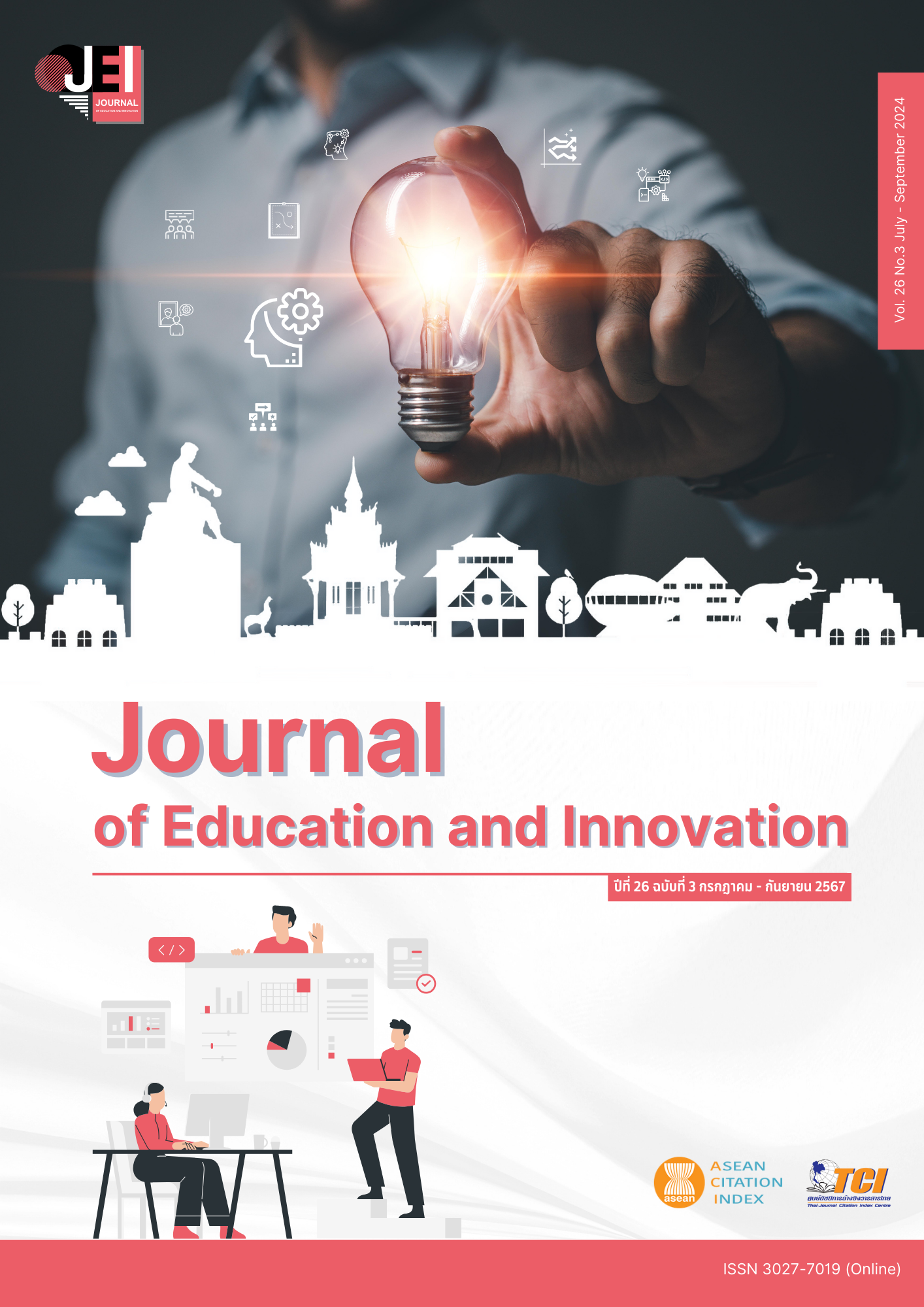การวิเคราะห์องค์ประกอบการเป็นองค์กรแห่งความสุขของสถานศึกษาเอกชน
Main Article Content
บทคัดย่อ
การวิจัยครั้งนี้มีวัตถุประสงค์เพื่อศึกษาองค์ประกอบการเป็นองค์กรแห่งความสุขของสถานศึกษาเอกชน โดยใช้ระเบียบวิธีวิจัยเชิงสํารวจ ผู้บริหาร ครู และบุคลากรสถานศึกษาเอกชนขั้นพื้นฐาน สังกัดสำนักงานคณะกรรมการส่งเสริมการศึกษาเอกชน ในเขตจังหวัดภาคเหนือตอนล่าง 9 จังหวัด จำนวน 373 คน ซึ่งได้มาจากการสุ่มอย่างง่าย เก็บรวบรวมข้อมูลด้วยแบบสอบถามแบบมาตราส่วนประมาณค่า 5 ระดับ จํานวน 53 ข้อ โดยมีค่า ความเชื่อมั่นเท่ากับ 0.96 วิเคราะห์ข้อมูลโดยใช้การวิเคราะห์องค์ประกอบเชิงสํารวจ โดยสกัด องค์ประกอบด้วยวิธีวิเคราะห์องค์ประกอบหลัก และหมุนแกนแบบมุมฉาก ด้วยวิธีแวริแมกซ์ ผลการวิจัย พบว่า องค์ประกอบ การเป็นองค์กรแห่งความสุขของสถานศึกษาเอกชน มีจํานวน 9 องค์ประกอบที่มีค่าน้ำหนักองค์ประกอบ ตั้งแต่ 0.518 ถึง 0.762 ได้แก่ 1) สถานศึกษามีบุคลากรที่มีคุณภาพ 2) สถานศึกษามีผลสัมฤทธิ์ที่ดีด้านการจัดการศึกษา 3) สถานศึกษามีบรรยากาศทางกายภาพที่ดี 4) ครูและบุคลากรมีสมดุลระหว่างชีวิตและการทำงาน 5) ครูและบุคลากรมีความสัมพันธ์ที่ดีต่อกัน 6) ครูและบุคลากรมีการวางแผนการดำเนินชีวิต 7) ครูและบุคลากรเป็นผู้มีความคิดแบบเติบโต
8) ครูและบุคลากรเป็นผู้มีการปฏิบัติตนที่ดี และ 9) ครูและบุคลากรมีแรงสนับสนุนในการทำงาน โดยทั้ง 9 องค์ประกอบเหล่านี้สามารถอธิบาย ความแปรปรวนการเป็นองค์กรแห่งความสุขของสถานศึกษาเอกชน ได้ร้อยละ 52.751
Article Details

This work is licensed under a Creative Commons Attribution-NonCommercial-NoDerivatives 4.0 International License.
เจ้าของบทความมิได้คัดลอก หรือละเมิดลิขสิทธิ์ของผู้ใด หากเกิดการละเมิดลิขสิทธิ์ ไม่ว่าวิธีใด หรือการฟ้องร้องไม่ว่ากรณีใด ๆ ที่อาจเกิดขึ้นได้ กองบรรณาธิการวารสารศึกษาศาสตร์ ไม่มีส่วนเกี่ยวข้องทั้งสิ้น ให้เป็นสิทธิ์ของเจ้าของบทความที่จะดำเนินการ
References
Aphaiphak, K. (2020). The Corporate Atmosphere of Happiness: Cheerful People, Successful Work. MCU Humanities Review, 6(1), 315-331.
Bura, K. (2017). Healthy Workplace: Concept process and the role of human resource professional. Academic Services Journal, Prince of Songkla University, 28(3), 169-176
Burton, J. (2010). WHO Healthy Workplace Framework and Model: Background and supporting literature and practice. Word Health Organization. https://iris.who.int/handle/10665/113144
Chaowachai, S., & Chatuprashewin, C. (2023). A causal relationship model of factors affecting the workplace happiness for teacher in private school. Journal of Education Naresuan University, 25(1), 295-303.
Chuayyim, K. (2020). Development of a model in creating happiness at work of administrators and teachers in schools under the Suratthani Primary Educational Service Area Office 2 (Doctoral dissertation). Suratthani: Suratthani University.
Faisong, S., & Klomku, L. (2022). Dharma principles for creating an organizationof happiness at work. Journal of MCU Nakhondhat, 9(6), 133-142.
Hair, J. F., Black, W. C., Babin, B. J., & Anderson, R. E. (2010). Multivariate data analysis (7th ed.). Upper Saddle River, NJ: Prentice Hall.
Jaithieng, K. (2019). The happy workplace management in primary school (Doctoral dissertation). Bangkok: Sillapakorn University.
Kaewdamkerng, K. (2014). Ways of creating happiness and factors for development of organizations that create happiness. Journal of Health Education, Mahidol University, 37(127), 1-15.
Kaewphichit, J. (2011). 102 Happy workplaces = Happy workplaces. Bangkok: Organizational Wellness Promotion Center.
Kusumalee, S. (2009). Decoding 100 Diverse Organizations. Bangkok: Thai Health Promotion Foundation.
Lowe, G. S. (2004). Health workplace strategies: creating change and achieving results. Toronto: The Gramhaw Group.
Manion, J. (2003). Joy at work: Creating a positive workplace. Journal of Nursing Administration, 33(12), 652-655.
Pinthong, S. (2013). Management model of the sports authority of Thailand as an organization of happiness (Doctoral dissertation). Bangkok: Kasetsard University.
Pinyo, T. (2012). Techniques for interpreting the results of factor analysis in research work. Panyapiwat Journal, 10(Special), 292–304.
Ramrong, T., & Ritmontri, S. (2018). Guidelines for Enhancement of Happy Organizations in Kasetsart University. Journal of Social Sciences and Humanities, 44(1), 185-208.
Regional Education Office No.17. (2023). Education Development Plan for the Lower Northern Province. Phitsanulok: Office of the Permanent Secretary, Ministry of Education.
Rungarunsaengthong, S., & Inrak, S. (2019). Efficiency of basic school management. Journal of Educational Administration, Silpakorn University, 10(2), 934-944.
Sinthanapanya, A., Songbundit, A., Boontima, R., & Supakit, W. (2020). Happiness management in school. Suthiparitat, 28 (88), 15-32.
Thai Health. (2009). Happy workplace. Bangkok: Thai Health.
Wasanthanarat, C. (2016). Let's build a happy organization. Bangkok: At Four Print.

